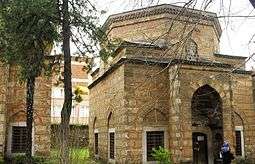Şirin Hatun
Şirin Hatun (Ottoman Turkish: شیریں خاتون) was a consort of Sultan Bayezid II of the Ottoman Empire.
| Şirin Hatun | |
|---|---|
 The mausoleum of Şirin Hatun located inside the Muradiye Complex, Bursa | |
| Died | Bursa, Ottoman Empire (present day Bursa, Turkey) |
| Burial | |
| Spouse | Bayezid II |
| Issue | Şehzade Abdullah Aynışah Hatun |
| Religion | Sunni Islam |
Life
Şirin married Bayezid when he was still a prince, and the governor of Amasya. She gave birth to Bayezid's eldest son, Şehzade Abdullah in 1463,[1][2] followed by a daughter, Aynışah Hatun.[3]
According to Turkish tradition, all princes were expected to work as provincial governors as a part of their training. In 1467-68, Şirin accompanied Abdullah, when was sent to Manisa, and then to Trabzon in early 1470s. In 1480, the two returned to Manisa, and following the 1481 succession struggle to Karaman.[2][4]
The Sultan had granted her the village of Emakin in Mihaliç. She endowed two schools, one in Bursa, and the another in Mihaliç. She also built two mosques, one in Eynesil,[5] and the other known as "Hatuniye Mosque" located inside Trabzon Castle in 1470.[6] For her endowments, she allocated the villages of Kabacaağaç and Kadi in Şile, as well as four existing mills on Koca Dere Creek in Şile.[5]
After the death of Şehzade Abdullah in 1483,[4] Şirin retired to Bursa. In retirement, she built a tomb for Abdullah, in which she was too buried at her death.[1][2][7]
References
- Uluçay 2011, p. 46.
- Uluçay, M. Çağatay. BAYAZID II. IN ÂILESI. p. 109.
- Uluçay, M. Çağatay (1956). Harem'den mektuplar, Volume 1. Vakit Matbaası. p. 68.
- Al-Tikriti, Nabil Sirri (2004). Şehzade Korkud (ca. 1468-1513) and the Articulation of Early 16th Century Ottoman Religious Identity – Volume 1 and 2. pp. 311–12.
- Hızlı, Mefail (1999). Mahkeme sicillerine göre Osmanlı klasik döneminde ilköğretim ve Bursa sıbyan mektepleri. Uludağ Üniversitesi Basımevi. p. 169. ISBN 978-9-756-95817-9.
- Horuluoğlu, Şâmil (1983). Trabzon ve çevresinin tarihi eserleri. Er Ofset Matbaacılık. p. 79.
- Sakaoğlu 2008, p. 190.
Sources
- M. Çağatay Uluçay (1985). Padişahların kadınları ve kızları. Türk Tarih Kurumu.
- Necdet Sakaoğlu (2008). Bu mülkün kadın sultanları: Vâlide sultanlar, hâtunlar, hasekiler, kadınefendiler, sultanefendiler. Oğlak Yayıncılık. ISBN 978-9-753-29623-6.